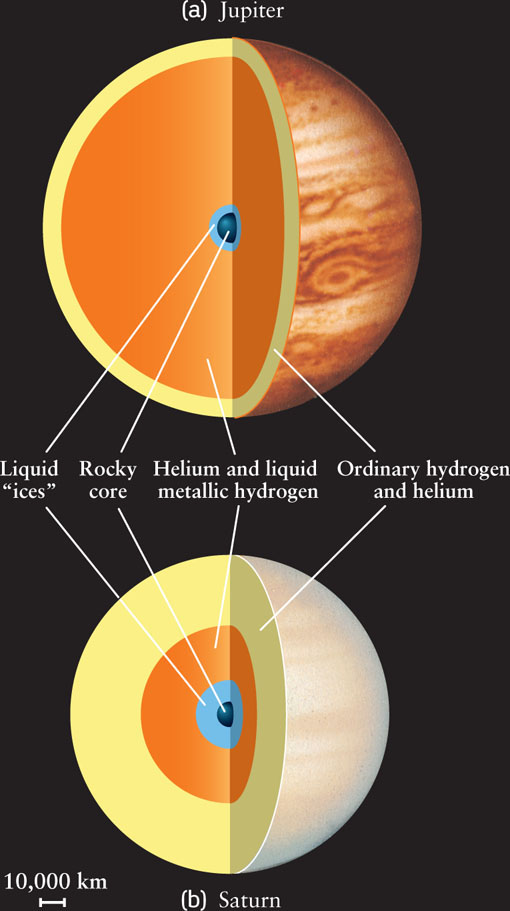12-6 The oblateness of Jupiter and Saturn reveals their rocky cores
The Galileo Probe penetrated only a few hundred kilometers into Jupiter’s atmosphere before it was crushed. To learn about Jupiter’s structure at greater depths, as well as that of Saturn, astronomers must use indirect clues. The shapes of Jupiter and Saturn are important clues, because they indicate the size of the rocky cores at the centers of the planets. When the Juno spacecraft reaches Jupiter, we will learn even more about the planet’s internal structure.
Oblateness and Rotation
Even a casual glance through a small telescope shows that Jupiter and Saturn are not spherical but slightly flattened or oblate. (You can see this in Figure 12-1 and Figure 12-2.) The diameter across Jupiter’s equator (142,980 km) is 6.5% larger than its diameter from pole to pole (133,700 km). Thus, Jupiter is said to have an oblateness of 6.5%, or 0.065. Saturn has an even larger oblateness of 9.8%, or 0.098, making it the most oblate of all the planets. By comparison, the oblateness of Earth is just 0.34%, or 0.0034.
If Jupiter and Saturn did not rotate, both would be perfect spheres. A massive, nonrotating object naturally settles into a spherical shape so that every atom on its surface experiences the same gravitational pull aimed directly at the object’s center. Because Jupiter and Saturn do rotate, however, the body of each planet tends to fly outward and away from the axis of rotation.
ANALOGY
You can demonstrate this effect for yourself. Stand with your arms hanging limp at your sides, then spin yourself around. Your arms will naturally tend to fly outward, away from the vertical axis of rotation of your body. Likewise, if you drive your car around a circular road, you feel thrown toward the outside of the circle; the car as a whole is rotating around the center of the circle, and you tend to move away from the rotation axis. (We discussed the physical principles behind this in Box 4-3.) For Jupiter and Saturn, this same effect deforms the planets into their nonspherical, oblate shapes.
Modeling Jupiter and Saturn’s Interiors

The oblateness of a planet depends both on its rotation rate and on how the planet’s mass is distributed throughout its volume. In general, the more a planet’s mass is concentrated in a solid core, the less oblate (or more spherical) the planet’s shape. The challenge to planetary scientists is to create a model of a planet’s mass distribution that is consistent with the observed oblateness and rotation rate. One such model for Jupiter suggests that 2.6% of its mass is concentrated in a dense, rocky core (Figure 12-13a). Although this core has about 8 times the mass of Earth, the crushing weight of the remaining bulk of Jupiter compresses it to a diameter of just 11,000 km, slightly smaller than Earth’s diameter of 12,800 km. The pressure at the center of the core is estimated to be about 70 million atmospheres, and the central temperature is probably about 22,000 K. By contrast, the temperature at Jupiter’s cloudtops is only 165 K.
If Jupiter formed by accretion of gases onto a rocky “seed,” the present-day core is presumably that very seed. Additional rocky material was presumably added later by meteoritic material that fell into the planet and sank to the center. If, however, Jupiter formed directly from the gases of the solar nebula, the meteoritic material that later fell in makes up the present-day core. Material from icy planetesimals, too, would have sunk deep within Jupiter and added to the core. In the model we have been describing, these “ices”—principally water (H2O), methane (CH4), ammonia (NH3), and other molecules made by chemical reactions among these substances—form a layer some 3000 km thick that surrounds the rocky core. (Because these substances are less dense than rock, they “float” on top of the rocky core.) Despite the high pressures in this layer, the temperature is so high that the “ices” are probably in a liquid state.
Saturn rotates at about the same rate as Jupiter but has less mass, and therefore less gravity to pull its material inward. Hence, Saturn’s rotation should cause material at its equator to bulge outward more than on Jupiter, giving Saturn a greater oblateness. In fact, if Saturn and Jupiter had the same internal structure, we would actually expect Saturn to be even more oblate than it really is. We can account for this discrepancy if Saturn has a different mass distribution than Jupiter. Detailed calculations suggest that about 10% of Saturn’s mass is contained in its rocky core, compared to 2.6% for Jupiter’s rocky core (see Figure 12-13b). Like Jupiter, the rocky core of Saturn is probably surrounded by an outer core of liquid “ices.”
CONCEPT CHECK 12-6
If Jupiter’s rotation rate was made large enough, could it be more oblate than Saturn?
Yes. All else being equal, increasing the rotation rate increases the oblateness.